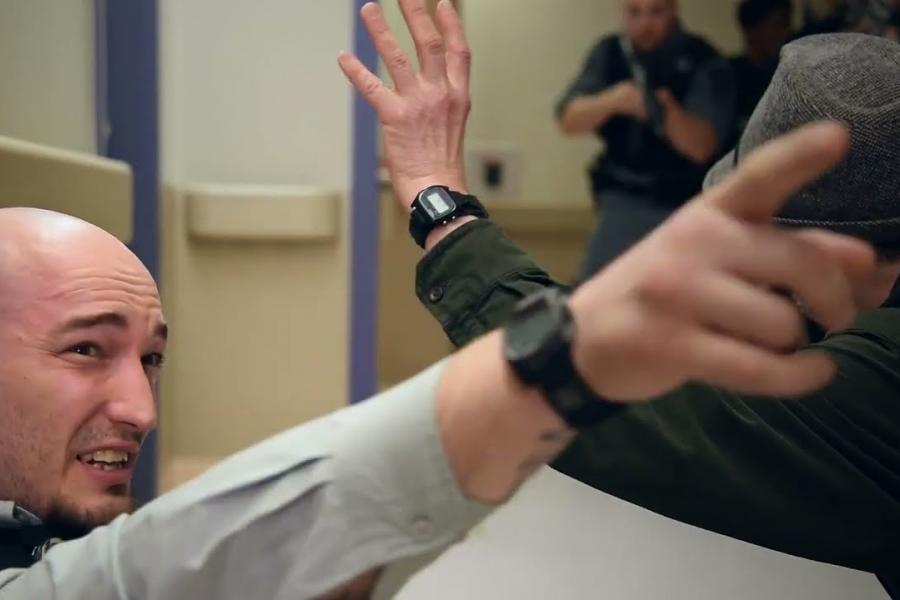Emergency procedures
The university has developed a comprehensive emergency response plan and provides access to an emergency notification system.
Emergency numbers
- Call 911 first (Ambulance, Fire, Police)
Then call Security Services:
- 555 from any university phone
- #555 from Bell MTS or Rogers Wireless
- 204-474-9341 from all other phones
- Any emergency phone on campus
Armed Intruder Information
If you are directed to take shelter and secure your location for safety reasons, you should take the following steps immediately if you are in an impacted area:
RUN: Evacuate If Possible.
- If there is considerable distance between you and the gunfire/armed person, quickly move away from the sound of the gunfire/armed person. If safe to do so, run out of the building and move far away until you are in a secure place to shelter.
HIDE: Hide silently in as safe a place as possible.
- If you cannot leave a building safely, hide in an area out of the armed person’s view.
- Choose a hiding place with thicker walls and fewer windows, if possible.
- Lock doors and barricade with furniture, if possible.
- Turn off lights.
- Silence phones and turn off other electronics.
- Close windows, shades and blinds, and avoid being seen from outside the room, if possible.
- If you are outdoors and cannot RUN safely, find a place to hide that will provide protection from gunfire such as a brick wall, large trees or buildings.
FIGHT: Take action to disrupt or incapacitate the shooter
- As a last resort, fight. If you cannot leave or hide safely and when your life is in imminent danger - take action.
- Attempt to incapacitate or disrupt the actions of the shooter, act with physical aggression and force.
- Use any items in your area you can find such as fire extinguishers or chairs to strike or throw at the armed person.
Call 911 when it is safe to do so. Wait for law enforcement or emergency officials to assist you exiting the building, if inside. When law enforcement or emergency officials arrive and clearly identify themselves, you must display empty hands with open palms.
This video was produced in conjunction with:
- Shared Health Manitoba
- Health Sciences Centre Winnipeg
- Winnipeg Police Service
- University of Manitoba
UM Safe App and Alerts
UM Safe is a mobile safety app that enhances the safety of students and staff on campus. The app sends safety alerts to your mobile device and provides instant access to campus safety resources.
Please register below to receive text alerts from the University of Manitoba’s UM Safe Alert System.
UM Safe app
Mass notification system
Mass notification system
The University of Manitoba has developed an Emergency Response Core Group, which is comprised of staff from the Environmental Health and Safety Office, Security Services, Physical Plant, Office of Risk Management, Public Affairs, IST and Student Affairs. This group has been organized to deal with communication and first response issues. An Emergency Manager is identified at all times, and the position is rotated between managers at EHSO, Security Services, Physical Plant and Information Services Technology (IST).
Emergency response plan
The Security Services Department plays a vital role in the University's Emergency Response Plan. Guards are often the first on scene at an emergency and, as such, are responsible for important roles such as scene containment and keeping the Dispatch Officer updated with critical information.
The Emergency Response Plan has several objectives. A large focus of the plan is outlining the role administration will play in managing the emergency itself. As well, the Plan addresses campus-wide issues to ensure the entire community is equipped to respond. Emergencies on campus are divided into three categories: Tier 1, Tier 2 and Tier 3; each requiring its own response and level of intervention.
Tier 1
- Small, localized event requiring a routine response.
- Event is contained and requires routine communication between units.
- Emergency Response Plan is not initiated.
- Response is by internal unit with outside agencies if necessary.
Tier 2
- Event is localized but involves a large disruption to the community.
- Response is shared with the university unit and external agencies.
- Emergency Response Plan is initiated.
- High urgency for communication between the various units and agencies.
Tier 3
- A widespread event requiring a critical response from internal and external agencies.
- Critical urgency for containment and communication.
- Emergency Response Plan is initiated.
- Multi-agency and multi-departmental shared response.

